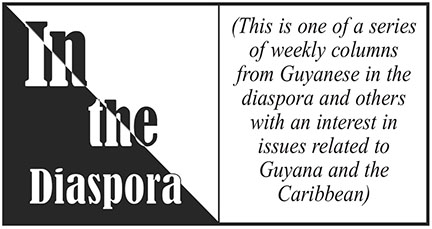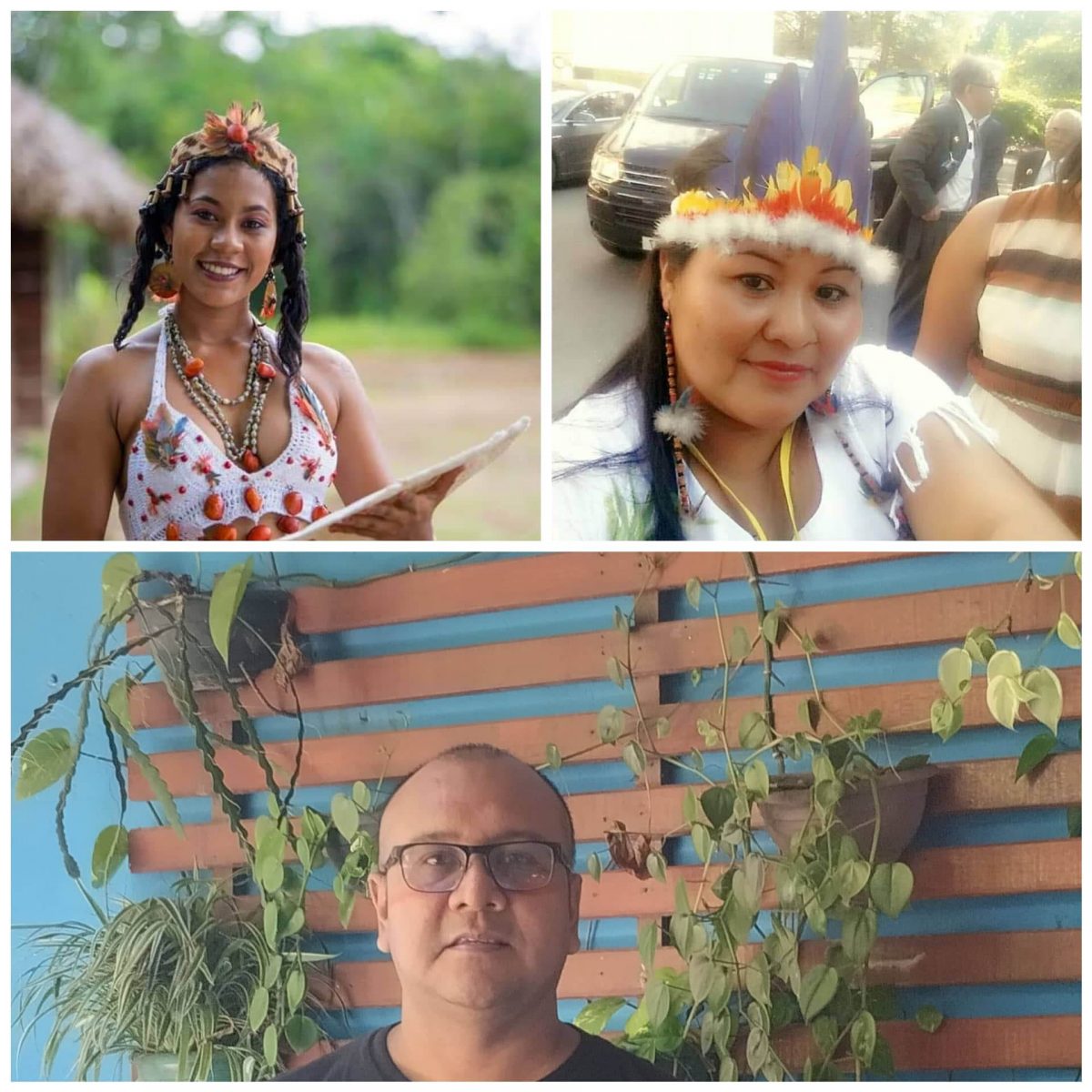
Immaculata Casimero is Wapichan from Aishalton. She is the women’s group coordinator of South Rupununi. Jylleina Da Silva is the current Indigenous queen of Cuyuni/Mazaruni, Region Seven. She is Lokono and a phlebotomy technician and is active in social issues. Medino Felician Abraham is Lokono from Moruca. He works with indigenous people on the Brazilian border with Guyana.
We offer these thoughts in observance of International Day of Indigenous Peoples 2022. In researching Indigenous people of the Caribbean Amazon of Northern South America, we found that Archaeological literature on pre-Columbian history by Brazilian Archaeologists like Pedro Mentz and Guyanese Denis Williams, among others, documented that our people inhabited the South American continent for thousands of years prior to 1492 when Columbus set foot on it. Their study along with other ethnohistorians further highlighted that at that time there was no Brazil, no Guyana, no Venezuela, etc., only a huge expanse of territory inhabited by native people. This understanding showed that Indigenous people inhabited the lands of modern-day Guyana which eventually evolved into a nation state.
Given this brief history, the country now has 10% Indigenous population which is growing in all 220 communities and in all 10 administrative regions across the country. Collectively our nine different groups reflect a cultural diversity from the coast to the Rupununi Savannahs and mountains. It is a demographic that possesses a wealth of languages, traditions, customs and beliefs; including natural resources in biodiversity and ecosystems that are conserved by our stewardship over the years. But unfortunately, at present this natural wealth is now faced with a threat, with an anthropocentric view of development that is triggered by talk of growing our gross domestic product (GDP) and politicians who use our efforts in conserving the forest to promote their fame on the international stage as champions of the earth.
With a growing population of 80,000, our numbers can enable us to have proper representation in parliament and be protagonists for change in decision-making affairs pertaining to lands, education and other critical areas that can permit us have a dignified life in Guyana. However, such an ambition can be a dream, given that the two dominant political parties comprised of mainly our coastal peoples don’t seem interested in creating such space for indigenous autonomy. We might say they are skeptical of our force and would prefer to do everything to split our ballots and label our voting demography as swing votes, which ultimately makes us subject to their neo colonial hegemony.
Living under this system doesn’t edify us in our villages, especially at election time. In our communities, local party members replicate the polarized division from the dominant rival gutter politics that takes place on the coast, and simultaneously use strategies to appease us in the form of government ‘aid and assistance,’ which is excellent, but which comes with agendas for the return of votes for political parties. This subordinate structure makes us as indigenous people subject to continuous paternalism by successive governments. Hence, to deal with this system there is need for us to form grassroots movements and empower ourselves by revisiting the trajectory and struggles of elders who fought in unity for the following achievements: our rights to lands; the creation of the Amerindian Act 2006; the National Toshaos Council (NTC) and other pivotal accomplishments even though efforts are made to control them by governments, as we have seen in last month’s National Toshao Council (NTC) meeting.
Collective empowerment can trigger initiatives, for example by developing District Councils in communities across the country, oriented by the Amerindian Act of 2006. Efforts can be made to educate our youth on the Amerindian Act, the United Nations Declaration on the Rights of Indigenous People (UNDRIP) as well as on Free Prior and Informed Consent (FPIC) that deals with decision-making processes without pressure and intimidation brought to bear upon communities. It includes seeking proper ways to deal with projects, particularly with regards to oil investment that can benefit our people in developing sustainable and efficient ways in villages. Additionally, a collective approach has the potential to assist the government in revising the Amerindian Act 2006 to be on par with international standards; to deal with critical issues that guarantee further demarcation of lands for growing populations and future generations and to regulate mining and environmental activities on our lands.
Besides dealing with colonial juridical systems that regulate land demarcations, there is need to apply collective efforts at community levels to address internal challenges triggered by inevitable transformations occurring in our communities and villages. Some of these are individualism in families and work environments; power drunk individuals in positions of authority; use of drugs and alcohol; teenage pregnancies; domestic violence; and the hesitation of some parents towards their children’s pursuit of formal education in some communities.
We must recognize that we have power in our hands, to take initiatives in forming groups to support one another, to look out for families that are in crisis and deal with social ills in communities. It is good to see women’s groups that are gradually surging; engaged in wonderful work in educating females about domestic violence and the attitude of men in communities. Parallel to this, there is need for Indigenous men to form groups to educate their brethren in decolonizing the macho mentality when it comes to treatment of the opposite sex, while recognizing that not all men are abusers, there are many good ones who respect women.
Since we are part of a multiethnic country we co-exist with other groups and are always interacting with the other, and in the process, transformation takes place; the other groups influence us and we also influence and learn from them. As such, it’s good to highlight the following sociolinguistic reality. This year, 2022 to 2032, begins the decade of Indigenous Languages designated by the United Nations. In this context, most of us speak English, our local languages and also Creolese. The latter is also part of our identity, especially for indigenous peoples who inhabit coastal areas. Thus, collectively, it is important to recognize Creolese as having an important role in children’s learning in schools which can trigger the revitalization of the other Indigenous languages in Coastal communities that are slowly dying, and simultaneously other languages such as: Wapichan, Patamona, Macushi, Acawaio, and Arecuna that are strongly spoken, and which need to be encouraged and promoted through community level initiatives.
It’s wonderful to see some of our Indigenous people upgrading themselves through education and as entrepreneurs. At the same time, we should be asking critical questions about attitudes which make us ‘money minded for development, where to build concrete houses that transform our communities into concrete jungles and pollute the environment with plastic junk, mirrors an attitude from the throwaway culture as a best standard to live by. This ‘modern’ sociocultural reality occurring in villages needs a collective response in education from our elders to balance modernity and tradition. Our elders are encyclopedias who possess a lot of experiences and knowledge of Indigenous cultures. They can advise and pass on wise teachings to young ones about care for the environment, about Indigenous economic knowledge, understanding of weather patterns, knowledge of spirituality and ancestral lands, all of which is important wisdom for sustainable development and preserving traditions for future generations.
Another aspect that is paramount is incorporating the benefits of modern science and technology in communities, to promote our languages, pursue opportunities in higher education, and be researchers of our own cultures because it seems it is mostly outsiders who have the economic means to produce studies on us, the “exotic people”. Furthermore, we must use modern technology to educate ourselves on matters like the current food prices in the world. Indigenous people are facing hardships in Guyana with rising cost of living even though government is giving cash grants to families, but are not enough to meet the expenses to feed families.
We must also be concerned about mining issues like the one at Chinese Landing, where we can show solidarity with fellow indigenous people there. The situation requires us to unite and encourage negotiation with the Government to resolve the matter, because today it can be Chinese Landing and tomorrow, it can be another community. Furthermore, our people must constantly be updating and educating ourselves on climate change; be attentive to how it is affecting our farms and livelihoods in communities, and seek solutions on how to adopt and be ‘climate smart’ to keep farms yielding produce in climate crises.
In concluding, as we reflect on International Day of Indigenous People 2022 in Guyana, we must recognize our potential if we are united and empowered to get things done: seeking justice and respect for our rights; dealing with transformations of climate change; becoming literate in modern technology; and being united and proactive to confront social issues in communities while contributing sustainably to Guyana’s development.






